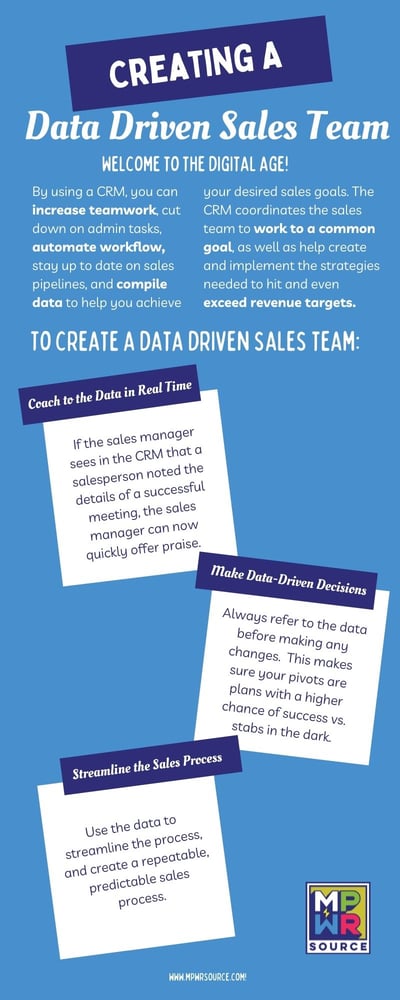Data is essential to successful sales. The idea that data analytics is important only to marketers is a misnomer. However, according to MIT Technology Review, only 0.5% of data available is used. As Jon Birdsong, CEO of Rivalry, said, “Sales managers who lead people with the help of data will be the ones we emulate.” Not long ago, everyone said, “Cash is king.” Well, times have changed; data is king.
What types of data should your sales team track?
According to HubSpot (and my experience), a sales team should be tracking the following data or key performance indicators (KPI):
- Total Revenue: The total amount of revenue your sales team generated.
- Total Sales by Time Period: How your sales team is performing over a period of time. (Improving or worsening)
- Sales by Lead Source: Where the sales are coming from and what lead generation sources are not working.
- Revenue Per Sale: How much revenue is generated by every sale made.
- Revenue by Product: How much revenue is generated by each product, product line, or service.
- Market Penetration: How much product or service is being used by customers as compared to the to the total estimated market.
- Sales Per Prior Activity: How many sales were made for each prior activity (e.g., phone calls, virtual calls, emails, in person meetings, etc.)
- Conversion Rate: How many deals won against the percentage of lost deals.
- Loss Rate: The percentage of deals lost during each phase of the sales cycle.
- Average Sales Cycle Length: How long it takes to close a sale, from the very start of a sales cycle to the very end.
- Response Time: The time between a customer’s inquiry and a salesperson’s response. The quicker the response time, the more likely a sale.
- Churn Rate: How many clients are lost month by month or year by year.
- Contact Report: For new business developers, this is their most valuable asset. The number of contacts should continually increase.
- Percentage of Revenue from New Business: How much revenue is generated from brand new customers.
- Percentage of Revenue from Existing Customers/Clients: How much revenue is generated from existing customers.
- Year Over Year (YOY) Growth: How the sales team performance is growing as compared to the previous year.
- Average Customer Lifetime Value (LTV): How much revenue can you expect one customer or client to generate throughout the business relationship.
- Net Promoter Score (NPS): The degree to which people would recommend your company to others.
- Number of Sales Lost to Competition: How many sales in a given time period are lost to competition.
- Percentage of Sales Reps Attaining 100% Quota: How many representatives on your team are attaining 100% quota.
- Revenue by Territory: How much revenue the sales team is generating by territory.
- Revenue by Market: How much revenue the sales team is generating by market.
- Cost of Selling as a Percentage of Revenue Generated: How much the company is paying to generate sales.
 How does knowing this data boost sales?
How does knowing this data boost sales?
In baseball, general managers and scouts study player statistics in order to make decisions on the abilities of the players. Managers, catchers, and pitchers also study statistics of batters on opposing teams to figure out how best to pitch to them and position the players on the field. The same should be true for sales managers and teams.
Sales manager and sales teams need to know the KPIs to make better decisions on how to coach and train their sales teams.
How does data help the sales team?
- Knows and understands the goals of the team and where they (collectively and individually) stand to goal.
- Knows what each team member needs to do reach their goal.
- Evaluates the sales process. If the process is working, the data will reflect it; thereby making the sales process predictable and repeatable. If the sales process is not working, you can make a change and clearly see if that change is improving or hurting the sales process.
- Can create a strategy to boost sales. For example, if the data suggests that certain buyers and prospects demand certain products or sales during a certain month of the year, a strategy can be created on how to target those buyers.
- Will utilize and track all data in a CRM because they understand and benefit from the data.
- Understand what prospecting methods work. For example, by tracking touch points, the sales team may understand that it takes 5 touch points for a prospect to become a client, i.e., 3 emails, 1 phone call, and 1 zoom meeting.
- Can zone in on prospects that qualify as good-fit leads. For example, the data may suggest that a good-fit lead is a customer or client with a certain annual revenue and certain number of employees.
- Ultimately, data saves time, energy, and money by streamlining the sales process to maximize revenue and business impact.
Where do you get the data?
Welcome to the digital age! A sales management system or client relationship management (CRM) serves as your single source of truth for your business. By using a CRM, you can increase teamwork, cut down on mundane admin tasks, automate workflow, stay up to date on data (including sales pipelines), and most importantly, compile data to help you ultimately achieve your desired sales goals. The CRM coordinates all salespeople on the sales team to work to a common goal, as well as help create and implement the strategies needed to hit and even exceed revenue targets. At MPWRSource, we use HubSpot’s Sales Hub, in conjunction with their free CRM, Marketing Hub, and CMS Hub.

 How do you get your entire team to be data driven?
How do you get your entire team to be data driven?
The data is only as good as those who input the data and use the data.
To create a data driven sales team:
Coach to the data in real time
For example, if the sales manager sees in the CRM that a salesperson noted the details of a successful meeting, the sales manager can now quickly offer praise. In contrast, if the salesperson noted the details of a meeting that didn’t go well, the sales manager can now offer immediate feedback. If needed, the sales manager will also know what training may be needed.
Make data-driven decisions
Don’t make decisions on hearsay or memory. Always refer to the data. For example, before changing a target market, evaluate the data to determine if the target market should be changed or reevaluated. Don’t just change the target market because another sales manager in a peer group said that his/her team had tremendous success in a certain industry.
Streamline the sales process
Use the data to streamline the process, and create a repeatable, predictable sales process.
Data is power, but only by analyzing and using the data, will your sales process and revenue soar to new heights.

 How does knowing this data boost sales?
How does knowing this data boost sales? 
 How do you get your entire team to be data driven?
How do you get your entire team to be data driven? 
